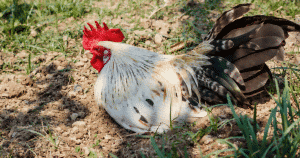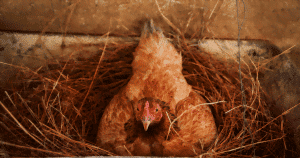The great mystery of the farming world is chicken behavior. We will share successful practices that every chicken keeper should follow or understand at some point in their egg-producing journey. So, why are chickens pecking around, and why are they acting silly all of a sudden?
Well, guess what scientists asked the same questions as us regular folks. By poking around in chickens, they have discovered a chicken genome. So now we all will understand how related we really are with chickens when searching for that ketchup bottle in the store before closing time, like a chicken searching for food before nightfall.
Here are some behaviors that chickens usually do and are expected in certain seasons.

Domestication and selection are still important today as they were in domestication times. Every chicken breed has a different trait that breeders choose. Some chickens are louder, and some are more laid back, quiet, or attending to their or other hens’ eggs, all for a reason to either survive or be loud in harsh environments pestered by praying animals. For a full indebt report, you can read our article about chicken breeds that are not just nice but also pretty.
For the most exciting chicken breed and the best well-mannered chicken, we recommend looking at Plymouth rock and Mille fleur d’uccle bantam.
Unique genetic features
Many of these breeds have a unique genetic features.
Feeding and foraging are activities that all chickens love, and they do it mainly during daylight hours. Chickens primarily feed in the morning and the evening. Playing birds are more active with their foraging. Chickens forage in a natural environment; they peck the ground almost daily. So, in a homemade situation, chicken keepers must provide feeding and foraging, so they feel connected to the habitat and have their freedom, making for better egg production.
Chickens like to roam free. So, a lot of room for roaming is a must when they forge and scratch or peck the ground in search of food and other creatures that live in the soil. You can also find a chicken searching for a place to take a dust bath. Or make a nest. They keep busy at all times. If they search and search, that’s when, you know, they are searching for a nest and that you will have a lot of scratched ground. Chickens like to be occupied, so if they’re not, they can be prone to stress, self-harm, and aggression amongst each other. So, their time alone is much needed. They are also social birds, so they must interact with one another and with humans from time to time.

Jet again, nesting should mimic nature’s environment—some chickens like one nest, and others like different nesting situations. So, if you have breed diversity in your flock, you should provide different nest box options. Some need more room; some need a more quiet and secluded space. Nest sites can be long-lasting, meaning they will nest there until they can. So, if your chickens display behavior of not liking a nest, you should change it to a more favorable one. When a hen develops a liking to one nest, she’s highly motivated to perform nesting behaviors and lay more eggs.
Changing the nest can remedy any frustrations arising from a denial of her nest. A good nest can also alleviate stress and makes hens feel more protected and safer, thus not having or remedying health problems.

They also like to be clean, and by dealing with this, they preen and take dust baths.
Chickens preen or perform maintenance with their beaks by reapplying oils to their feathers not to catch pests living under their wings. They do so by pecking at their tail that produces a lot of skin oil, and then they collect it in their beak and distribute the oil throughout their wings and feathers. They do this so that the feathers are insulated and waterproof. In addition, they take dust baths to prevent infestation, so having loose soil helps.
Domesticated chickens learn quickly to perch and appear to calm down more when their standards properly meet their environment. Chickens like to escape from other flock mates or need to warm up against them. Either way, chickens, in most cases, use perches or elevated structures 12-20 inches from the ground. They like to sleep high from the ground and roost like that also. If roosting is prevented the hens become agitated and aggressive.
Hens have fertilized or unfertilized eggs when they brood. Usually, they start to sit on their or other hens’ eggs in waiting for a chicken to be hatched. They sit on the eggs day and night, leaving only once daily to eat, drink, and poop. In most cases, the egg is not fertilized, so you must be careful to help the hen get out of her brooding mode to prevent health risks. If you try to remove her from her eggs, she may hiss and peck at you, so you must be creative to lure her out of the nest and back with others. Our Run-Chicken team suggests golf balls if you have one on hand.
Broodiness occurs in female chickens due to genetics, high levels of hormones in the spring, lighting conditions that change with seasons, and flocks group instincts to reproduce. A problem of aggression in a flock can occur if there is only one egg in a nest and two broody hens. In this case, you must use a trick to get both out of the nest or resort to a quick fix of an artificial egg that temporarily solves the aggression among them.
You can spot brooding behavior when hens pluck their feathers for bedding in a nest. Brooding hens sit for about 20 days at a time. They protect their offspring by making vocal signals as hissing, screeching, growling, and pecking. If one hen is broody, there is a slight chance that other hens in the flock will become broody too.
Most bird species possess acute hearing and high range color vision. Because of that, they are also good communicators. They often make signals to one another and humans when they feed them. They display themselves and vocalize their meaning day to day. Especially in mating rituals, postures and displays are mainly used, then vocalizing.
Chickens communicate with more than 24 vocalizations. Any good chicken keeper will tell you that the number and types of vocalizations are limited in domestic chickens if you listen closely in comparison to wild birds. Chickens vocalize their intentions to other birds in the flock frequently during the day and establish order and hierarchy in the flock. Postures and displays are often used to signal threats and submit one chicken to another.
A fun fact, the Brazilian hummingbird has the highest pitched sound in the bird kingdom compared to a rooster that has a lower pitch sound but he can hold notes for longer.
Most roosters have an excellent comb size and hue so that their beauty influences the females and their social status. Comb length is also essential in recognizing dominance between chickens because one male has a better dominant position if it has a profound and larger comb than others. Breed, size, color code, and body weight influence the status displayed between your chickens in your flock.
Dominance for space is also common in domestic chickens. Many of the flock suffer if they don’t have enough room to disperse daily. Female chickens maintain proximity to dominant males. In that regard, the rooster has the most dispersion in the flock. Females from the flock generally stick together, but they maintain the pecking order of dominance. Female chickens mainly do not show aggression, but males do. Younger hens have fewer rights and are at the bottom of the hierarchy. Older hens rule the flock under the rooster. Brooding hens for a while lose their pecking spot, and because of that, if they don’t have a fertile egg, you must encourage them to go back outside so that the brooding hen doesn’t encounter problems and is cast aside. Dispersion often occurs at the beginning of each breeding season, so seasons always align the order. A flock can easily break apart and come together later in the season.
Hens and roosters have the most interaction when they are mating. Males display courtship in a very noisy way that involves vocalizations, big postures like spreading the feathers, all in an attempt to persuade the female to mate and seem more significant and emphasized. In this way, the female recognizes his good genes and mates with him.
A mother chicken will start communicating with her chicks while they’re still in the egg. Interestingly, birds vocalize and communicate right out of the egg too. Bird embryos make low-frequency sounds even in the egg when they are developing. Communication thus starts from the inside of the egg, and siblings communicate between themselves before they are hatched. That is how chicks usually recognize their brood mates outside the egg. Even then, they establish a pre-hierarchy that helps them later on in mating. Because of their communication, they develop different mating behaviors to avoid mating between themselves.
If left by themselves, roosters mate later in their lives because they do not have other competitive males to compare with. If you have two roosters in the flock, you can notice that high-ranking roosters have a different vocalization than low-ranking males. On the other hand, hens also display a fondness for certain roosters and space themselves closely. A hen with high status is less likely to crouch for males than a low ranking one.
Your flock can also display some characteristics in proportion to mating. For example, sometimes, only a few females mate with a rooster. So low ranking, females rarely mate and are brooding with a fertile egg.
Housing density or inappropriate housing can also affect mating behaviors. So, if you encounter problems with that, you should consider changing or sprucing your accommodation. The presence of males also influences the production of eggs in females. So, a rule of thumb is to have no more than 14 hens per rooster. There is also a risk of having a larger flock in a smaller space. It can increase mortality, skin damage, and other social behavior problems such as hysteria. Hysteria in birds is described as panic that results in ill birds.
Dominant birds can also peck at submissive birds, pluck their feathers, and chase them away or steal the food they have foraged. Submissive birds will not peck back and usually run from the dominant birds and hide. If a bird is added or removed from the flock, the entire flock will readjust and fight to harmonize the dominance order. Flocks greater in size (more than 14 birds) can lead to excessive fighting and less egg production. If you have more than one rooster, you should keep them away from each other. They tend to fight or abuse one another, even sexually. It can also result in one bird killing another for status.
Chicken behavior is sometimes misunderstood or taken as not important. If you have some exciting and educational stories for other chicken keepers, please share them on Facebook or Instagram. We’d love to read and discuss them with our followers. You can also chat in our beloved FB group Chicken and Egg lovers.











